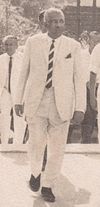Ceylonese parliamentary election, July 1960
|
|
||||||||||||||||||||||||||||||||||
|---|---|---|---|---|---|---|---|---|---|---|---|---|---|---|---|---|---|---|---|---|---|---|---|---|---|---|---|---|---|---|---|---|---|---|
|
||||||||||||||||||||||||||||||||||
|
151 seats to the House of Representatives of Ceylon 76 seats were needed for a majority |
||||||||||||||||||||||||||||||||||
|
||||||||||||||||||||||||||||||||||
|
||||||||||||||||||||||||||||||||||
Dudley Senanayake
United National Party
Sirimavo Bandaranaike
Sri Lanka Freedom Party
General elections were held in Ceylon (now Sri Lanka) in July 1960.
The March 1960 election had left neither of Ceylon's two major parties with a majority, so another election was inevitable.
The Sri Lanka Freedom Party, which had been in disarray since the murder of its leader S.W.R.D. Bandaranaike the previous year, settled on his widow, Sirimavo, as its new leader. She pledged to continue her husband's policies, notably the Sinhala Only Act, and to proceed with repatriation of the estate Tamils to India.
The United National Party, led by Dudley Senanayake, had a similar position towards the island's minorities. Its differences with the SLFP were over economic policy. The SLFP called for a socialist program of nationalization of both private enterprises and religious schools; the UNP preferred to leave both in private hands.
The SLFP obtained a bare majority, despite getting a lower share of the popular vote than the UNP, and Mrs. Bandaranaike became prime minister.
...
Wikipedia


